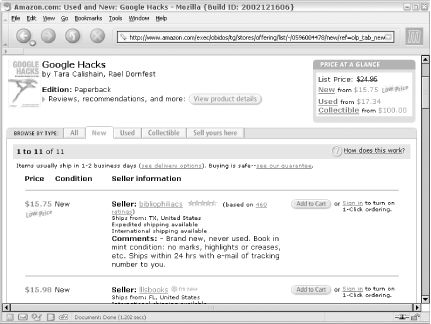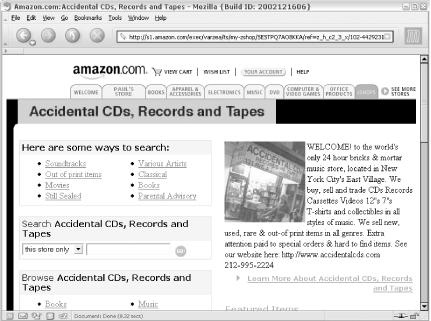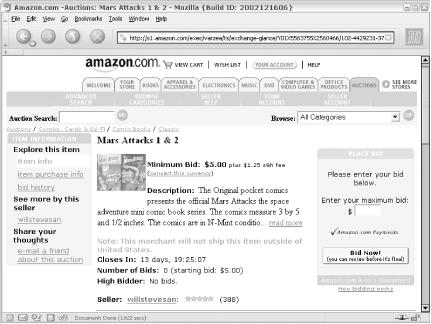Amazon has several systems in place that allow different ways of selling through their site. Understanding how each system works (and what they cost) will help you choose how you’d like to list your items on Amazon.
Amazon sells new and used books by third parties side by side with their own catalog. Underneath the “Add to Shopping Cart” button on product detail pages, you’ll find a box called “More Buying Choices” shown in Figure 4-1.
If you click the “used & new” link, you’ll find a list of sellers. Figure 4-2 shows a list of sellers offering Google Hacks for sale.
Just who are these sellers? They’re primarily individuals and small businesses. Anyone can sell a product from these pages. Amazon refers to this system of third parties selling items from their catalog as Marketplace [Hack #49].
Buying a new, used, or collectible item from a Marketplace seller is the same process as buying from Amazon. The only difference is what happens after your order is placed. Amazon notifies the specific Marketplace seller, and the seller ships the item to you. Amazon handles all the payment details and deposits the money from the sale directly into the sellers account—taking a cut for brokering the transaction, of course.
Each seller has a 1-5 star rating based on comments left by previous customers. This works as a reputation system that lets you read others’ comments about the seller before buying, and leave comments about the transaction afterward.
Pro-Merchant Subscription is a program Amazon offers to large-volume sellers. For a monthly fee, sellers get lower listing fees, get some tools to upload sale item information in higher quantities [Hack #51], and can have an unlimited number of items listed. In addition, Pro-Merchant subscribers can offer alternate payment methods like personal checks, direct credit card payments, or C.O.Ds.
Pro-Merchant subscribers also have access to Amazon’s zShops system. A zShop is a virtual storefront through which sellers can sell almost anything. An item doesn’t have to be available in Amazon’s catalog to be sold in a zShop.
Tip
By almost anything, Amazon means that certain items can’t be sold through their site. It’s worth reading through the Prohibited Content guide (http://www.amazon.com/o/tg/browse/-/537784/). Beyond learning how to stay in compliance with their terms of service, you’ll find out about the sketchy things people have tried to sell online in the past.
zShops can have customized storefronts with a business logo and custom graphics. For example, New York-based brick-and-mortar music shop Accidental CDs has a custom zShop storefront shown in Figure 4-3. Potential customers can also search a shop’s inventory and browse product areas.
To get a feel for how people are setting up their zShops, start browsing through them at the zShops home page (http://www.amazon.com/zshops/).
Another option for selling through Amazon is listing items and letting others bid on them [Hack #55]. In addition to the thrill of watching the bids rise for a product you’ve listed, Amazon’s per-item fee is a bit lower. Your item won’t be listed in their product detail Marketplace listings, but it will be available through the Amazon Auctions section (http://www.amazon.com/auctions/). A typical auction item, in this case a pair of comic books, is shown in Figure 4-4.
If you have products that aren’t listed in Amazon’s catalog, but you want Amazon to list them and handle all the shipping and customer interaction, you’re looking for the Advantage Program. The price is steep (55% commission at this writing), but you simply send your products to Amazon and they do most of the heavy lifting. There are tools to manage your listings and upload information about your products. You can learn more at http://www.amazon.com/advantage/.
Though it’s not technically selling a physical item, Amazon’s Honor System helps you collect fees for your services. If you spend hours and hours slaving over your web site, you can ask your readers to pitch in for the effort. You can think of the Honor System as a tip jar for your site [Hack #57]. By adding a bit of code to your site, you can use Amazon’s payment infrastructure to collect a tip from your readers; Amazon will send you the money after taking a commission. You can find some examples of how people are using the program at the Honor System home page (http://www.amazon.com/honor/).
Seeing how Amazon’s selling program fees and services compare with each other could help you determine which program makes sense for you to use. Keep in mind that these could change at any time.
- Marketplace
$0.99 listing fee for each item, and 15% of the sale price. Each item is listed for a maximum of 60 days before it must be manually relisted. You ship each item and handle any issues with customers.
- Marketplace with Pro-Merchant Subscription
$39.99/month, and 15% of the sale price. No listing fee. Items are listed indefinitely.
- Auctions
$0.10 listing fee per item, and 5% of the sale price. The percentage decreases based on the sale price. The higher the price, the lower the percentage taken.
- Advantage Program
$29.95/year, and 55% of the sale price. Amazon handles inventory tracking, shipping, and customer service.
- Honor System
$0.15 per transaction and 15% of the payment.
Get Amazon Hacks now with the O’Reilly learning platform.
O’Reilly members experience books, live events, courses curated by job role, and more from O’Reilly and nearly 200 top publishers.





